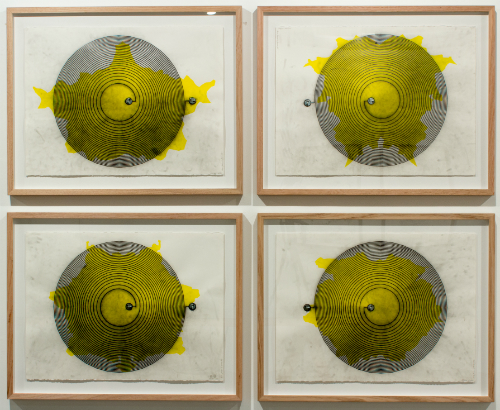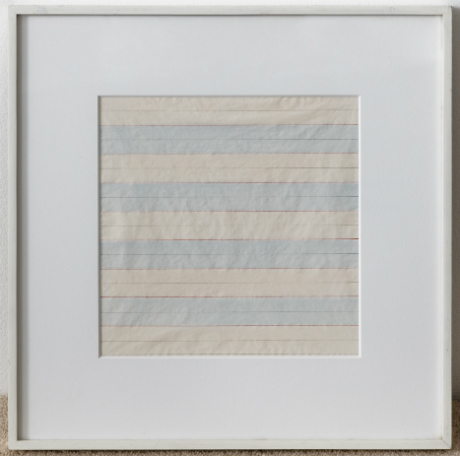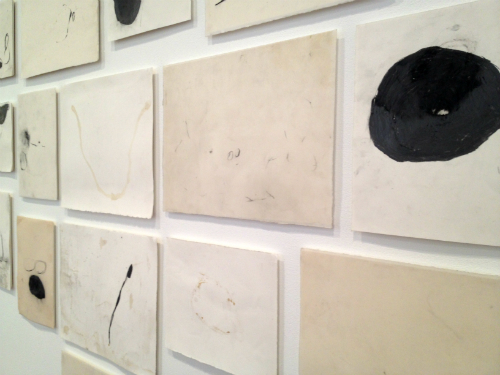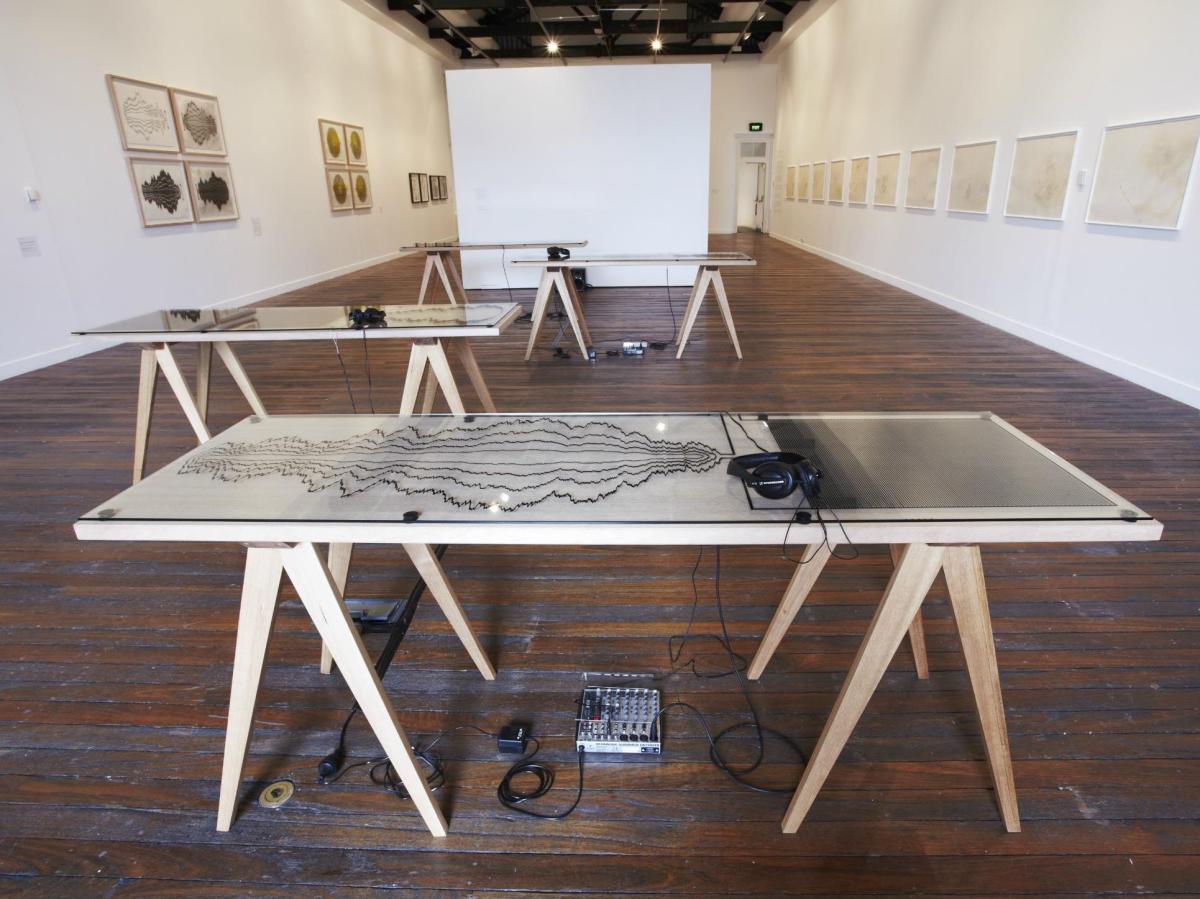Installation view Objects and Energies at NAS Gallery.
Currently, the National Art School is presenting two drawing shows that couldn’t be any more different, and yet there is an underlying sympathy that explores the seduction of observation and natural phenomena which links these disparate exhibitions in an odd yet timeless way.
In the lower gallery is the touring exhibition The Art of Science: Remarkable natural history illustrations from Museum Victoria, which takes that era infatuated with natural history – 19thc botanical studies – and draws it through to contemporary documentation, equally passionate in subject, but liberated by technology.
Surprising is the scale of John James Audubon’s rather violent studies of the early 1800s, which hold their presence alongside photomontages by Ken Walker at their 1mm magnification, or the delicate conversation between John Gould’s studies with Peter Trusler skeletal notations. As you would expect this exhibition is heavily didactic but it is surprising not weighted by its tradition.
It is the exhibition on the upper level of NAS Gallery, however, that has captured my interest, three women – Joyce Hinterding, Agnes Martin, Linda Matalon – drawn together in examination under the title theme Objects & Energies.
Curator Katie Dyer said that it is ‘an exhibition about the impulse to make the invisible visible’, and in that we can start to find that subtle link to the exhibition downstairs.
Among the three, Hinterding we perhaps best know in Australia for mapping acoustic phenomena and electromagnetic fields through a range of media, often inviting the viewer to “activate” her graphite drawings.

Joyce Hinterding’s Fields and Loops as installed at NAS Gallery. Courtesy the artist and NAS
In the exhibition we move between her earlier examples, what she calls Dirty Drawings with that record of performative engagement of grubby fingers, to two later installations of her carbon compositions set up on trestle tables, cleanly sheeted off with glass.
It is a rare opportunity to see Hinterding’s work loosely juxtaposed with the legendary Agnes Martin, their scale, gesture and bold embrace of technology seemingly so adverse, and yet the mapping of minute fluctuations and natural phenomena sit central to both.
As you move through a suite of ten lithographs by Martin from 1991, your eye starts to gravitate to the sense of hand in these seemingly obsessive formal grids that obsessed Martin for most of her life. These drawings breathe through their irregularities not unlike Hinterding’s recorded vibrations.
This exhibition presents a rare moment to see one of Martin’s watercolours on rice paper – a piece loaned by Fairfax dating from 1978. Surprise is its strength of colour; the meter of a red line locks the composition into order, and yet the sense of hand remains as light as the translucent paper.

Rare Agnes Martin drawing from 1978 at NAS Gallery.
We rarely get to see works by Martin in Australia, and if for one reason only to visit this show, then this is a good one.
Dyer offers a lovely leap from Martin’s grids to New York artist Linda Matalon, whose work she first experienced when she worked at New York’s The Drawing Center in the early 1990s.
Shown for the first time in Australia, Matalon – described by American critic Roberta Smith as a Post-Minimalist – is the antithesis of Martin’s formality, and yet the burnished beeswax surfaces of her drawings have a thin luminosity sympathetic with Martin’s choice of translucent papers.
At the same time the beeswax gives them a kind of fleshiness – a physicality – where the eye and body come together. It is a link Dyer draws back to Hinterding, who plays out that physicality most literally.

Detail of Linda Matalon’s drawing installation at NAS Gallery.
Spatially Matalon’s drawings break the formality of the exhibition, presented in a clustered ground and then as a long wall of studies marching the length of the gallery. They have a different kind of “weight” and energy than Hinterding and Martin’s drawings.
Dyer makes the point that the connectivity across this exhibition lies not with the artists’ affinity with the natural world but rather through ‘their embrace of abstraction and non-objectivity – in a sense translating and imagining what is in the mind as much as the possible worlds our bodies inhabit.’
It is an erudite observation of Dyer’s, and one that places the viewer in a refreshing position to rethink the language of drawing. Some may call this a bland or blank show – the work occupying the almost cathedral-like space of the gallery with little demand other than the time for consideration.
Dyer gives us three artists little known or under-celebrated in Australia, but like Robert Rauschenberg’s erasure of a de Kooning drawing that challenged the passage of structure and the resonance of an object, this exhibition, Objects & Energies: Joyce Hinterding, Agnes Martin and Linda Matalon is one that stays with you long after leaving the gallery.
Rating: 4 out of 5 stars
Objects & Energies: Joyce Hinterding, Agnes Martin and Linda Matalon
National Art School, Sydney
31 January – 29 March
nas.edu.au/NASGallery/Current-Exhibition-and-Events
The exhibition is touring to:
Broken Hill Art Gallery 29 November to 22 February 2015, Western Plains Cultural Centre, Dubbo from 6 March to 7 June 2015 and Toowoomba Regional Art Gallery 15 June to 2 August 2015.
Public talks:
Art Forum lunchtime lecture at National Art School, Wednesday, 26 March at 1 – 2pm.
Linda Matalon and Joyce Hinterding in conversation in the NAS Galleries, Saturday, 29 March from 11am.
Coincinding with the exhibition Matalon will be artist-in-residence with NAS and Broken Hill Art Gallery, where the exhibition will tour after it closes at NAS Gallery.
Matalon’s travel and residencies have been supported by a Cultural Fund grant and grants from Museums & Galleries of NSW and the Copyright Agency Limited.





